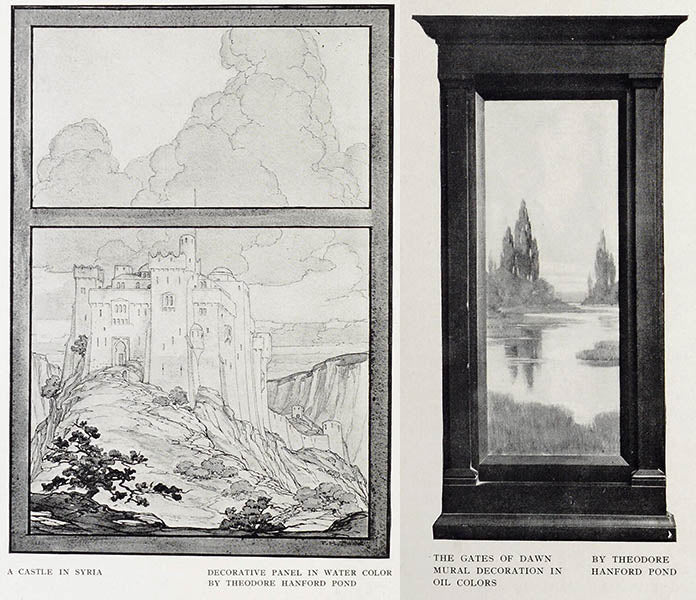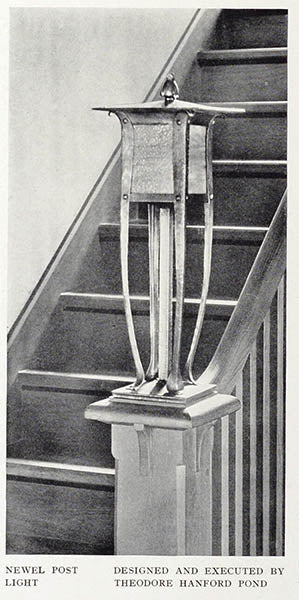Your Cart is Empty
FREE standard shipping to the continental US.
FREE standard shipping to the continental US.
FREE standard shipping to the continental US.
H3200
This flower-form box by Pond is the most sophisticated piece of silver by Pond we have ever seen. Its importance is cemented by its inclusion in the seminal 1987 arts & crafts exhibition The Art that is Life.
Four hibiscus (?) petals emanating from the center of the lid define the shape of the box with convex sides and shaped corners. These petals also form the dome of the lid, which is surmounted by a spherical finial randomly indented to replicate nature. The hammered surface shimmers in the light.
Theodore Hanford Pond (1873-1933) was at the center of the arts and crafts movement as a metalsmith, potter, designer, instructor, and administrator. He worked in copper (see: here and below); idiosyncratic silver flatware by him occasionally comes on the market, but silver holloware is very rare.
After graduating from the Pratt Institute in 1892, Pond started by working for Louis Comfort Tiffany designing stained glass, then became well-known during his career as an instructor, lecturer, administrator, and director - working at the Rhode Island School of Design, The Rochester Mechanics Institute (later RIT), The Maryland Institute, The Dayton Museum of Arts and The Akron Art Institute.

For a brief period from 1911-14, Pond left the institutional world and ran his Pond Applied Arts Studios in Baltimore. He and his talented assistants created jewelry, lighting, copper, silver, ceramics, and mural art.

Pond was a proficient artist in many media and a "direct and devoted student of nature" (1) whose best designs were inspired by the natural world.

His works speak elegantly of the time and place they were made. Pond lectured against the separation of designer and artisan in the industrial company. (2) For the few years his Pond Applied Art Studio existed in Baltimore, Pond had the opportunity to work closely in a collaborative shop with his student apprentices at the apex of Baltimore's arts & crafts movement.
His studio, "rather unique in this country,...remains open through the summer, and since the Instruction is entirely individual students may enter at any time...a system of apprenticeship, such is in vogue in England, is followed...A portion of the day is spent in theoretical design and the remainder in practical shop work. A graduated scale of pay has been arranged whereby students become wage earners after the first three months." (3)
His legacy today is that of an important educator and administrator. (4) The pieces he created during his few working artisanal years in Baltimore testify to his skills as a designer, artisan, and collaborator. This box is the most sophisticated piece of silver we have seen by him.
Provenance: Sotheby, Parke, Bernet, March 27, 1980, lot 263
Private Collection
Exhibition: "The Art that is Life": The Arts & Crafts Movement in America, 1875-1920, traveling exhibition 1987-88, Museum of Fine Arts, Boston, Los Angeles County Museum of Art, Detroit Institute of Art, Cooper-Hewitt Museum.
Literature: Wendy Kaplan, ed, "The Art that is Life": The Arts & Crafts Movement in America, 1875-1920, discussed and illustrated p. 331.
This stunning box is marked POND/ HAND/ WROUGHT/ STERLING along with his Pond Applied Art Studio dragonfly KWO-NE-SHE trademark. It measures 3 inches high by 3.9 inches wide and 3.9 inches deep and is in very good/ excellent antique condition, with a separated hinge.
(Before Longfellow appropriated him, Hiawatha was an Iroquois hero. In Longfellow's poem, Kwo-Ne-She is the dragonfly. It is unknown if Pond aligned himself with the Pan-Indian movement of the early 20th century. Other members of the arts & crafts community in the mid-Atlantic region did.)
Endnotes:
Sign up to get the latest updates and current musings in our occasional newsletter…